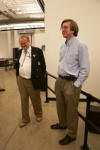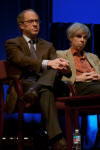
The Stanford Singularity Summit
May 13, 2006
Saturday, May 20, 2006
Sections
Alt.Mail
Special Reports
Larry Niven and I drove up to the Stanford Singularity Summit. Shortly afterwards I did a quick report which was sent to subscribers.
This expands that report and adds pictures. I wish I had time to do something more complete.
All photographs courtesy of Roland Dobbins.
Hoover Tower, The Stanford University Signature Building
Hoover Institution on War Revolution and Peace
I have returned from the Stanford so-called Summit Conference on "the Singularity." (http://sss.stanford.edu/ )
"The Singularity" is the time when all the trend curves go vertical; it is a time when we can no longer predict the future. One of the trends will be in Artificial Intelligence (AI): a self-aware, self-modifying AI will come into existence, after which it will modify itself to be even smarter. I first heard of this from Vernor Vinge (http://mindstalk.net/vinge/vinge-sing.html) in a serious paper published in 1993; Vernor has also written of these matters in his science fiction.
I found it very interesting and very much worth the trip, but then Niven and I got a lot of work done on INFERNO on the drive up, so even if the conference had been a bust it would have been worthwhile to go. I regret that Vernor Vinge had a previous obligation and couldn't drive up with us. Not many in the conference mentioned Vinge: apparently they were trying to be taken seriously and didn't want to be associated with a science fiction author? But then they did invite Niven and me, and had Cory Doctorow on the speaker list, so perhaps that is not it. In any event, there was little about Vinge and not much more about science fiction. John McCarthy speculated that one reason for this conference was to attract the attention of venture capitalists, and they didn't want it to look too wild. I have no opinions on that.
While in Stanford I had dinner with Niven, John McCarthy (for the one or two who don't know, the founder of the Stanford Artificial Intelligence Laboratory or SAIL), and my two colleagues/friends/advisors Roland Dobbins and Peter Glaskowsky. I was also able to spend a couple of hours with Roland, Peter, John, and Larry Niven after the conference, and at dinner I sat with Doug Hofstadter, who has since sent me a long letter about his impressions of what went on.
![]()
Photos left to right: John McCarthy listens to the presentation; McCarthy with Niven and Pournelle; Me with Peter Glaskowsky; Two views of Dinner with Doug Hofstadter.
![]()
A quick summary: we aren't to "the singularity" in which all the trend curves go vertical at once, and no one seems to know when we will get there.
Kurzweil believes that the probability is high that we'll get there before 2020 and very high before 2050.
Doug Hofstadter once wrote an article about "Who will be we in 2093" but later revised that to 2493 for a variety of reasons. His Gödel, Escher, Bach has been a highly influential book since its first publication in 1979. Hofstadter has revised his views several times, and now believes that while the singularity is likely, we are not as close as Kurzweil believes.
Cory Doctorow had little to nothing to say about the Singularity, and most of his talk was about the evils of copyright. I've examined these matters in other places, and I have nothing new to report, but we did have a fairly intense discussion.

Eric Drexler is optimistic, and says that "Self-replicating nano-bots are off the table. They're just not in the picture." This is intended to allay fears that we will all be turned into grey goo.
At lunch we had this discussion:
ME: "Why are self replicating nano-bots no longer in the picture?"
Eric: "No constituency?"
Me: "It only takes a constituency of one."
Eric: "If we're lucky it will be too hard for one person to do."
With that we changed the subject. I found that Eric and Wil McCarthy are not in communication, which is surprising since Wil (Hacking Matter) seems to be running a reasonably well funded nano-tech lab. There has been progress in nano-technology, with many small advances in the creation of features, structures, and such. And Kurzweil pointed out in his talk that seven years into the genome project they had only done 1% of it. He didn't refer to "The 29th Day", but that came to mind.
(If you have an exponential growth of algae in a pond, and on the 30th day it was saturated, what was the concentration on the 29th day?")
![]()
Lunch with Eric Drexler
![]()
IN The Strategy of Technology, Possony and I pointed out that almost all technological progress goes in ogive or "S" curves: those look like exponentials, but they have inflection points, and progress begins to slow at the top of the curve; they don't go vertical and they are not true exponentials. Example: speed of aircraft. Of course there is often a series of S curves: again, aircraft airspeed is a good example, riding steadily during the propeller era, then suddenly flattening; followed by the jet engine S curve.
It is extremely likely that progress toward AI will go in a series of S curves; but it doesn't mean that at different times it won't LOOK a lot like an exponential.
Kurzweil and Hofstadter
Roy Kurzweil argued that the exponentials have begun, and there is nothing that can stop the singularity, which will happen when robots and intelligent machines evolve through LaMarkian processes rather than Mendelian.
My dinner conversation with Hofstadter was fascinating.
I came away from the conference with these two conclusions:
All progress in AI so far has been in closed and definable systems (Chess, driving a car from Barstow to the Nevada border, etc.; what we generally call 'expert systems')
And, from what I observe, those who talk about singularities and artificial intelligence live in relatively closed and definable communities -- what might once have been called an Ivory Tower.
The second observation came from listening to the speakers and the program (http://sss.stanford.edu/ ). I am not at all sure they have been much impacted by the real world. The SAIL accomplishment in the Grand Challenge of course did have to deal with a real world (the Mojave desert) but even there it was much restricted, and of course there was no intelligent malevolence at work.
I put these observations to both McCarthy and Hofstadter, and got no cogent objection; but of course either may rethink that position, so don't take this as definitive.
I also came away with the objection that although this was billed as the Singularity Summit, there was not one sentence on what the Singularity would be like, or even a definition:
What is the sign or portent we should watch for so that we will know that the Singularity is Nigh?
Jesus said that no man could predict the Millennium. So far that seems to be the case with The Singularity. And while we know that in the Millennium there will be The Rapture of the Saints, and Christ will return in clouds of glory, we don't know the Singularity even to that detail. (Of course on some views Revelation is more symbolic than literal, but then on some views "strong" AI with Lamarckian evolution of Intelligence is only science fiction.)
We also don't know the relative probabilities of the two events, since one would probably preclude the other.
But those are matters for another time.
![]()
A grab bag of pictures from Sanford. Chris Peterson, me, the audience, John McCarthy at coffee after the event, me explaining the IMP to Niven: we were both on the early ARPA-Net; another shot of me in the Computer Museum (well worth a report on its own); and me in my "Jerusalem hat" which I bought from a Palestinian in Israel during our visit there.
![]()

















